+ Open data
Open data
- Basic information
Basic information
| Entry | Database: PDB / ID: 2oi9 | ||||||
|---|---|---|---|---|---|---|---|
| Title | Structure of the 2C/Ld/QL9 allogeneic complex | ||||||
 Components Components |
| ||||||
 Keywords Keywords | IMMUNE SYSTEM / TCR / MHC | ||||||
| Function / homology |  Function and homology information Function and homology informationT cell receptor complex / antigen processing and presentation of peptide antigen via MHC class I / lumenal side of endoplasmic reticulum membrane / defense response / MHC class I protein complex / phagocytic vesicle membrane / adaptive immune response / immune response Similarity search - Function | ||||||
| Biological species |  | ||||||
| Method |  X-RAY DIFFRACTION / X-RAY DIFFRACTION /  SYNCHROTRON / SYNCHROTRON /  MOLECULAR REPLACEMENT / Resolution: 2.35 Å MOLECULAR REPLACEMENT / Resolution: 2.35 Å | ||||||
 Authors Authors | Garcia, K.C. / Colf, L.A. | ||||||
 Citation Citation |  Journal: Cell(Cambridge,Mass.) / Year: 2007 Journal: Cell(Cambridge,Mass.) / Year: 2007Title: How a single T cell receptor recognizes both self and foreign MHC. Authors: Colf, L.A. / Bankovich, A.J. / Hanick, N.A. / Bowerman, N.A. / Jones, L.L. / Kranz, D.M. / Garcia, K.C. | ||||||
| History |
|
- Structure visualization
Structure visualization
| Structure viewer | Molecule:  Molmil Molmil Jmol/JSmol Jmol/JSmol |
|---|
- Downloads & links
Downloads & links
- Download
Download
| PDBx/mmCIF format |  2oi9.cif.gz 2oi9.cif.gz | 96.8 KB | Display |  PDBx/mmCIF format PDBx/mmCIF format |
|---|---|---|---|---|
| PDB format |  pdb2oi9.ent.gz pdb2oi9.ent.gz | 74.2 KB | Display |  PDB format PDB format |
| PDBx/mmJSON format |  2oi9.json.gz 2oi9.json.gz | Tree view |  PDBx/mmJSON format PDBx/mmJSON format | |
| Others |  Other downloads Other downloads |
-Validation report
| Summary document |  2oi9_validation.pdf.gz 2oi9_validation.pdf.gz | 453.5 KB | Display |  wwPDB validaton report wwPDB validaton report |
|---|---|---|---|---|
| Full document |  2oi9_full_validation.pdf.gz 2oi9_full_validation.pdf.gz | 461.7 KB | Display | |
| Data in XML |  2oi9_validation.xml.gz 2oi9_validation.xml.gz | 18.9 KB | Display | |
| Data in CIF |  2oi9_validation.cif.gz 2oi9_validation.cif.gz | 26.6 KB | Display | |
| Arichive directory |  https://data.pdbj.org/pub/pdb/validation_reports/oi/2oi9 https://data.pdbj.org/pub/pdb/validation_reports/oi/2oi9 ftp://data.pdbj.org/pub/pdb/validation_reports/oi/2oi9 ftp://data.pdbj.org/pub/pdb/validation_reports/oi/2oi9 | HTTPS FTP |
-Related structure data
| Related structure data |  2e7lC  1ldpS  2ckbS C: citing same article ( S: Starting model for refinement |
|---|---|
| Similar structure data |
- Links
Links
- Assembly
Assembly
| Deposited unit | 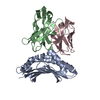
| ||||||||
|---|---|---|---|---|---|---|---|---|---|
| 1 |
| ||||||||
| Unit cell |
| ||||||||
| Components on special symmetry positions |
|
- Components
Components
| #1: Protein | Mass: 20941.064 Da / Num. of mol.: 1 / Fragment: alpha 1,2 domains / Mutation: F9Y, V12T, I23T Source method: isolated from a genetically manipulated source Source: (gene. exp.)   |
|---|---|
| #2: Protein | Mass: 12487.985 Da / Num. of mol.: 1 Source method: isolated from a genetically manipulated source Source: (gene. exp.)   |
| #3: Protein | Mass: 13268.437 Da / Num. of mol.: 1 Source method: isolated from a genetically manipulated source Source: (gene. exp.)   |
| #4: Protein/peptide | Mass: 1063.202 Da / Num. of mol.: 1 / Source method: obtained synthetically / Details: Synthesized peptide |
| #5: Water | ChemComp-HOH / |
| Has protein modification | Y |
-Experimental details
-Experiment
| Experiment | Method:  X-RAY DIFFRACTION / Number of used crystals: 1 X-RAY DIFFRACTION / Number of used crystals: 1 |
|---|
- Sample preparation
Sample preparation
| Crystal | Density Matthews: 3.82 Å3/Da / Density % sol: 67.81 % |
|---|---|
| Crystal grow | Temperature: 298 K / Method: vapor diffusion, sitting drop / pH: 7.2 Details: 0.9M sodium dihydrogen phosphate, 0.01M di-potassium hydrogen phosphate, pH 7.2, VAPOR DIFFUSION, SITTING DROP, temperature 298K |
-Data collection
| Diffraction | Mean temperature: 100 K |
|---|---|
| Diffraction source | Source:  SYNCHROTRON / Site: SYNCHROTRON / Site:  SSRL SSRL  / Beamline: BL11-1 / Wavelength: 0.97908 Å / Beamline: BL11-1 / Wavelength: 0.97908 Å |
| Detector | Type: ADSC QUANTUM 315 / Detector: CCD / Date: Apr 20, 2006 |
| Radiation | Protocol: SINGLE WAVELENGTH / Monochromatic (M) / Laue (L): M / Scattering type: x-ray |
| Radiation wavelength | Wavelength: 0.97908 Å / Relative weight: 1 |
| Reflection | Resolution: 2.35→141.42 Å / Num. obs: 29820 / % possible obs: 99.92 % / Observed criterion σ(I): -3 / Redundancy: 5 % / Rmerge(I) obs: 0.078 / Rsym value: 0.078 / Net I/σ(I): 17.3 |
| Reflection shell | Resolution: 2.35→2.43 Å / Redundancy: 4.7 % / Rmerge(I) obs: 0.488 / Mean I/σ(I) obs: 2.5 / % possible all: 99.96 |
- Processing
Processing
| Software |
| ||||||||||||||||||||||||||||||||||||||||||||||||||||||||||||||||||||||||||||||||||||||||||
|---|---|---|---|---|---|---|---|---|---|---|---|---|---|---|---|---|---|---|---|---|---|---|---|---|---|---|---|---|---|---|---|---|---|---|---|---|---|---|---|---|---|---|---|---|---|---|---|---|---|---|---|---|---|---|---|---|---|---|---|---|---|---|---|---|---|---|---|---|---|---|---|---|---|---|---|---|---|---|---|---|---|---|---|---|---|---|---|---|---|---|---|
| Refinement | Method to determine structure:  MOLECULAR REPLACEMENT MOLECULAR REPLACEMENTStarting model: 1LDP, 2CKB Resolution: 2.35→60 Å / Cor.coef. Fo:Fc: 0.938 / Cor.coef. Fo:Fc free: 0.936 / SU B: 5.221 / SU ML: 0.124 / Cross valid method: THROUGHOUT / ESU R: 0.243 / ESU R Free: 0.183 / Stereochemistry target values: MAXIMUM LIKELIHOOD Details: FUSION PROTEIN COMPRISES chain B (T cell receptor alpha chain), the LINKER (GGGGSGGGGSGGGGSGGGGS), chain C(T cell receptor beta chain) and c-terminal tail with sequence HHHHHH. There is not ...Details: FUSION PROTEIN COMPRISES chain B (T cell receptor alpha chain), the LINKER (GGGGSGGGGSGGGGSGGGGS), chain C(T cell receptor beta chain) and c-terminal tail with sequence HHHHHH. There is not LINK record for chain B and LINKER, nor LINK for LINKER and chain C because the LINKER was not visible. HYDROGENS HAVE BEEN ADDED IN THE RIDING POSITIONS.
| ||||||||||||||||||||||||||||||||||||||||||||||||||||||||||||||||||||||||||||||||||||||||||
| Solvent computation | Ion probe radii: 0.8 Å / Shrinkage radii: 0.8 Å / VDW probe radii: 1.4 Å / Solvent model: MASK | ||||||||||||||||||||||||||||||||||||||||||||||||||||||||||||||||||||||||||||||||||||||||||
| Displacement parameters | Biso mean: 44.752 Å2
| ||||||||||||||||||||||||||||||||||||||||||||||||||||||||||||||||||||||||||||||||||||||||||
| Refinement step | Cycle: LAST / Resolution: 2.35→60 Å
| ||||||||||||||||||||||||||||||||||||||||||||||||||||||||||||||||||||||||||||||||||||||||||
| Refine LS restraints |
| ||||||||||||||||||||||||||||||||||||||||||||||||||||||||||||||||||||||||||||||||||||||||||
| LS refinement shell | Resolution: 2.353→2.414 Å / Total num. of bins used: 20
|
 Movie
Movie Controller
Controller



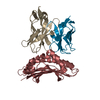
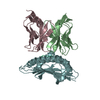
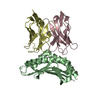
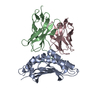
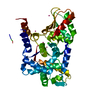

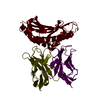


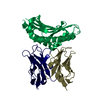
 PDBj
PDBj


